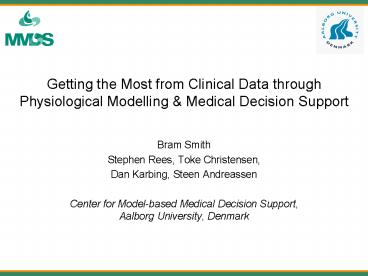Getting the Most from Clinical Data through Physiological Modelling
1 / 8
Title:
Getting the Most from Clinical Data through Physiological Modelling
Description:
Clinical monitor (ECG, HR,...) Interpretation. Metabolic (VO2, VCO2,...) Lung (Shunt, V/Q, ... ECG, SaO2,... CO2, Vt,... CO, MAP,... ALL data input is written ... –
Number of Views:28
Avg rating:3.0/5.0
Title: Getting the Most from Clinical Data through Physiological Modelling
1
Getting the Most from Clinical Data through
Physiological Modelling Medical Decision
Support
- Bram Smith
- Stephen Rees, Toke Christensen,
- Dan Karbing, Steen Andreassen
- Center for Model-based Medical Decision Support,
Aalborg University, Denmark
2
Introduction
- EXISTING TECHNOLOGY
- Clinical databases allowing easy, automated
storage and retrieval of patient data. - Medical equipment allowing data collection on a
PC. - Physiological models and decision support
systems. - BUT
- Doctors are still faced with interpreting large
amounts of data to diagnose patients. - PROPOSED SOLUTION
- An architecture that combines existing database
technology with physiological models and decision
support algorithms to assist clinicians in
diagnosing and treating patients.
3
Systems architecture
- Clients on the architecture can be divided into 3
types - Inputs User inputs, or data taken automatically
from medical equipment. - Interpretation Uses equations and physiological
models to expand knowledge about the patient. - Decision support Uses decision support
algorithms to assisting in choosing suitable
treatment strategies.
Inputs Ventilator (Paw, Flow,) Gas analysis (O2,
CO2) Clinical monitor (ECG, HR,)
Interpretation Metabolic (VO2, VCO2,) Lung
(Shunt, V/Q,) Blood (Base excess, DPG,)
Decision support Monitoring Ventilator
control Glucose regulation
Database
Architecture is compartmentalised to allow
independent development of each client.
4
Input clients
- Many monitors allow data logging on a computer
for automated data collection. - The user interface also allows clinicians to add
data that can not be logged automatically.
CO, MAP,
ECG, SaO2,
CO2, Vt,...
Vt, Paw,
Values, Events
Database
ALL data input is written to the database.
5
Interpretation clients
- Physiological models and more basic calculations
are carried out on data in the database to
determine more abstract measurements or patient
condition and extend the knowledge of the
patient. - Some clients can be automatic, carrying out
calculations when ever new data is available,
while more complex clients may require user
control.
Automatic
Requires user control
Body surface area
Cardiac Index
Oxygen Consumption
ALPE
Weight Height
BSA CO
FetO2, Vt,
VO2, CI,
Shunt, DPO2
BSA
CI
VO2
Database
6
Decision support clients
- The extended data set can be sorted and displayed
in a way that assists clinicians in diagnosis and
treatment selection. For example - Analysing how a particular measurement has
changed with time. - Displaying only data that is relevant for the
patients disorder. - Methods of assisting in optimising treatment
selection.
- Optimal
- PEEP,
- FiO2,
- Vt,
- History of
- Shunt,
- Deadspace,
- Insulin,
- Heart failure,
- ARDS,
- COPD,
Optimal insulin infusion
INVENT
Relevant information only
Hyperglycaemia
Plot history
PEEP, Vt,
Shunt, DPO2
Database
7
Implementation
CO, MAP, ITBV,
ECG, SaO2,
CO2, Vt, Paw,
O2, CO2
O2, CO2
CO2, Vt, Paw,
Decision Support e.g. ALPE
8
Conclusions
- A generic architecture has been implemented for
development of new calculation methods,
physiological models and decision support
systems. - The compartmental design means that clients can
be developed and function independently, yet
interact if possible to improve functionality
(eg, cardiopulmonary interaction, VO2). - This architecture presents a method for moving
information systems from audit to clinical
support tools, through - Calculation of abstract representations of
patient condition (e.g. cardiac index, shunt). - Assistance in interpreting patient information
and choosing optimal treatment strategies (e.g.
optimising ventilator settings).































